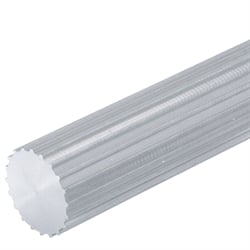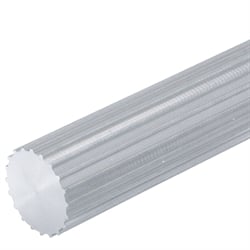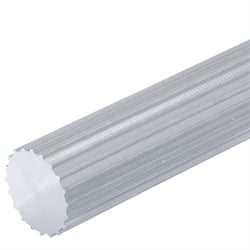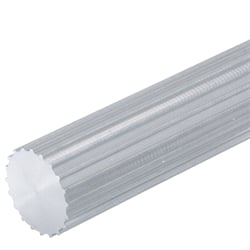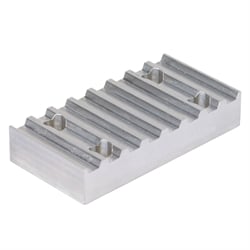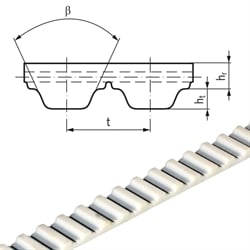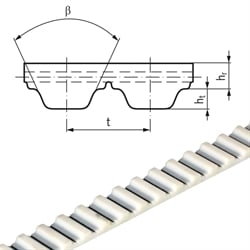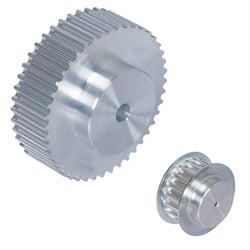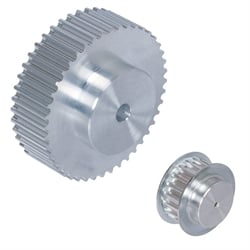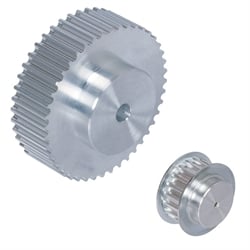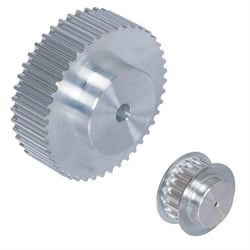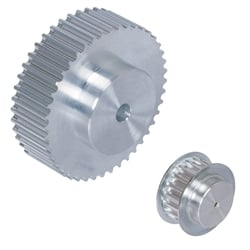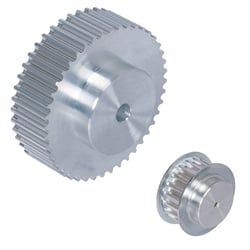Timing belt and pulley
Description
Timing belt drives ensure quiet operation and synchronous power transmission. Because they are maintenance-free, these drives are highly cost-effective. Due to changing requirements and considering the latest developments, there are a large number of different profiles, belt types, and pulleys available on the market. When non-positive drives (e.g., V-belt systems) are replaced, it is worth considering whether a conversion to a positive power transmission can be allowed from a safety perspective (some drives require slipping under overload). Selection and Sizing: The material of the belt and the type of timing belt must be chosen with consideration for the specific situation (e.g., required characteristics related to the machine or the environment). There are performance tables and a user-friendly calculation program to assist you in selecting the correct size. Small pulley diameters shorten the lifespan, and at least 6 teeth should be engaged at all times. When consulting the performance tables, various application-specific operating factors should be taken into account. Installation and Maintenance: At least one pulley must be equipped with flanges. The shafts must be parallel (deviation < +0.5°). The belt should not be overloaded during installation. Adequate adjustment options in the system should be provided for the assembly and adjustment of the ideal belt. Belt Tension: Each belt requires a certain pretension, depending on the type of belt, pulley diameter, center distance, and the tangential force to be transmitted. The total sum of tension and peripheral force should not exceed the allowed tensile strength of the belt. Belt tension is best adjusted by changing the center distance. Alternatively, a smooth idler pulley on the outside or a toothed one on the inside of the belt can be used for adjustment. Efficiency: Depending on the type of belt (flexibility) and the number of teeth on the pulley (bending), the efficiency can reach 98%. Belts with tension cords made of fiberglass (HTD and Inch) are particularly flexible.
Selection and sizing
The belt material and timing belt type must be chosen taking into account the specific situation (e.g. required characteristics related to the machine or the environment). There are performance tables and an easy-to-use calculation program to help you select the right size. Small pulley diameters shorten lifetime. And at least 6 teeth must be engaged at any time. When consulting the performance tables, several application-specific operating factors must be taken into account.
Assembly and maintenance
At least one pulley must be equipped with flanges. The axes must be parallel (deviation < +0.5°). The belt must not be overloaded during installation. For mounting and adjustment of the ideal belt, sufficient adjustment options must be provided in the system..
Belt tension
Each belt requires a certain pretension, depending on the type of belt, the diameter of the pulleys, the center distance and the tangential force to be transmitted. The total sum of the tension and the peripheral force must not exceed the permitted tensile force of the belt. The belt tension can best be adjusted by changing the center distance. Otherwise, a smooth idler pulley on the outside or a toothed one on the inside of the belt can be used for adjustment..
Efficiency
Depending on the type of belt (flexibility) and the number of teeth on the pulley (bending), the degree of efficiency can reach 98%. Belts with tensile bands made of fiberglass cords (HTD and Inch) are particularly flexible..
Some products in this category
| Product | DESCRIPTIOn | PICTURE |
|---|---|---|
|
16960000
Maedler |
Polyurethane timing belt AT20 width 50mm 50 AT20 open length with tensile members from steel packed 2 x 25mm |
|
|
16970000
Maedler |
Polyurethane timing belt AT20 width 75mm 75 AT20 open length with tensile members from steel packed 3 x 25mm |
|
|
16980000
Maedler |
Polyurethane timing belt AT20 width 100mm 100 AT20 open length with tensile members from steel packed 4 x 25mm |
|
| Products | ||
|---|---|---|
|
16894000
Maedler timing bar AT10 40 teeth length 160mm material aluminium |
||
|
16894200
Maedler timing bar AT10 42 teeth length 160mm material aluminium |
||
|
16894400
Maedler timing bar AT10 44 teeth length 160mm material aluminium |
||
|
16894800
Maedler timing bar AT10 48 teeth length 160mm material aluminium |
||
|
16895200
Maedler timing bar AT10 52 teeth length 160mm material aluminium |
||
|
16895600
Maedler timing bar AT10 56 teeth length 160mm material aluminium |
||
|
16896000
Maedler timing bar AT10 60 teeth length 160mm material aluminium |
||
|
16897000
Maedler timing bar AT10 70 teeth length 160mm material aluminium |
||
|
16899900
Maedler Fixing plate for timing belts material aluminium AT10 belt width 50mm |
||
|
16899901
Maedler Fixing plate for timing belts material aluminium AT10 belt width 100mm |
||
|
16960000
Maedler Polyurethane timing belt AT20 width 50mm 50 AT20 open length with tensile members from steel packed 2 x 25mm |
||
|
16970000
Maedler Polyurethane timing belt AT20 width 75mm 75 AT20 open length with tensile members from steel packed 3 x 25mm |
||
|
16980000
Maedler Polyurethane timing belt AT20 width 100mm 100 AT20 open length with tensile members from steel packed 4 x 25mm |
||
|
17021000
Maedler Timing belt pulley HTD 3M material aluminium 10 teeth for belt width 9mm |
||
|
17021400
Maedler Timing belt pulley HTD 3M material aluminium 14 teeth for belt width 9mm |
||
|
17021500
Maedler Timing belt pulley HTD 3M material aluminium 15 teeth for belt width 9mm |
||
|
17021600
Maedler Timing belt pulley HTD 3M material aluminium 16 teeth for belt width 9mm |
||
|
17021700
Maedler Timing belt pulley HTD 3M material aluminium 17 teeth for belt width 9 mm |
||
|
17021800
Maedler Timing belt pulley HTD 3M material aluminium 18 teeth for belt width 9mm |
||
|
17022000
Maedler Timing belt pulley HTD 3M material aluminium 20 teeth for belt width 9mm |
||
Would you like to get your best price or more information about this product?
Machine builders or engineering companies can request a login via the link below or contact us immediately.
Are you a private customer?
The manufacturer or importer of your machine probably has the necessary parts. We therefore recommend contacting them first.
